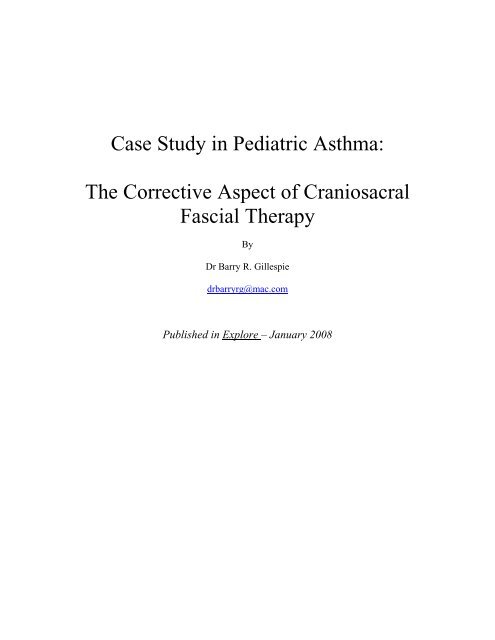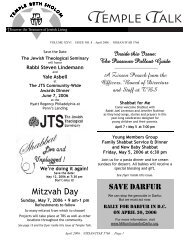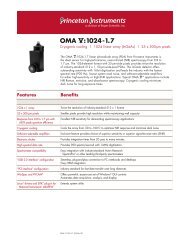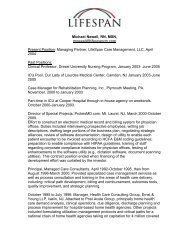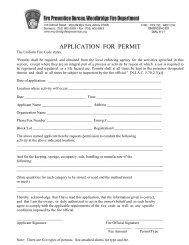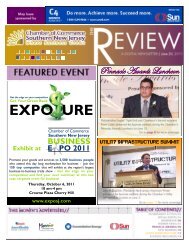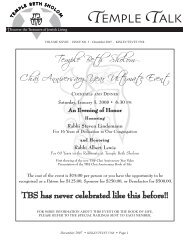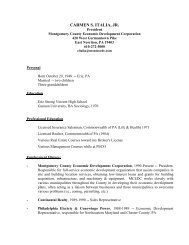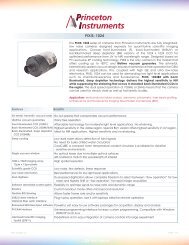Case Study in Pediatric Asthma: The Corrective Aspect of ...
Case Study in Pediatric Asthma: The Corrective Aspect of ...
Case Study in Pediatric Asthma: The Corrective Aspect of ...
Create successful ePaper yourself
Turn your PDF publications into a flip-book with our unique Google optimized e-Paper software.
<strong>Case</strong> <strong>Study</strong> <strong>in</strong> <strong>Pediatric</strong> <strong>Asthma</strong>:<br />
<strong>The</strong> <strong>Corrective</strong> <strong>Aspect</strong> <strong>of</strong> Craniosacral<br />
Fascial <strong>The</strong>rapy<br />
By<br />
Dr Barry R. Gillespie<br />
drbarryrg@mac.com<br />
Published <strong>in</strong> Explore – January 2008
INTRODUCTION<br />
<strong>Asthma</strong> is an <strong>in</strong>flammatory disorder <strong>of</strong> the airways that causes wheez<strong>in</strong>g,<br />
shortness <strong>of</strong> breath, chest tightness, and cough<strong>in</strong>g. 1 N<strong>in</strong>e million children <strong>in</strong> America<br />
under the age <strong>of</strong> eighteen have been diagnosed with asthma. 2 <strong>The</strong> asthma rate <strong>in</strong><br />
American children under the age <strong>of</strong> five has <strong>in</strong>creased more than 160% from 1980 to<br />
1994. 3 Approximately 5,000 Americans die every year from asthma. 2 Healthcare costs <strong>in</strong><br />
America for asthma are over sixteen billion dollars annually. 2 An estimated 300 million<br />
people <strong>of</strong> all ages and ethnic backgrounds from all over the globe suffer from asthma and<br />
approximately 250,000 people a year die from it. 4<br />
Current Western treatment focuses on manag<strong>in</strong>g asthma with two types <strong>of</strong><br />
medication. In the first group anti-<strong>in</strong>flammatory drugs (corticosteroids) reduce swell<strong>in</strong>g<br />
and mucous formation <strong>in</strong> the airways. Secondly, bronchodilators relax the smooth muscle<br />
cells that tighten around the airways; the child’s breath<strong>in</strong>g improves when the<br />
tracheobronchial tree opens. 5<br />
An alternative strategy for reduc<strong>in</strong>g and potentially even elim<strong>in</strong>at<strong>in</strong>g asthma<br />
symptoms <strong>in</strong>volves manipulation <strong>of</strong> the craniosacral fascial system. This system is an<br />
<strong>in</strong>tegration <strong>of</strong> the craniosacral and fascial or connective tissue components. William<br />
Sutherland D.O. discovered the craniosacral aspect about one hundred years ago. 6 He<br />
found that the cranial bones and sacrum moved as the bra<strong>in</strong> “breathed”. More recently<br />
John Upledger D.O. furthered the concept by discover<strong>in</strong>g that the stra<strong>in</strong> from trauma was<br />
primarily held <strong>in</strong> the connective tissue <strong>of</strong> the cranial dura and not the bones. 7<br />
In the craniosacral concept human physiology is strongly dependant on the slight<br />
motion <strong>of</strong> the bra<strong>in</strong> and sp<strong>in</strong>al cord and the fluctuation <strong>of</strong> the cerebrosp<strong>in</strong>al fluid with<strong>in</strong><br />
the men<strong>in</strong>geal and osseous systems. 8-15 Craniosacral theory holds that trauma can impair<br />
the normal rhythms <strong>of</strong> this fluctuation and result <strong>in</strong> disease and organ dysfunction.<br />
Manual therapy can help rebalance these natural nervous system rhythms and allow a<br />
return to health. 16<br />
Craniosacral therapy is currently be<strong>in</strong>g recognized as an important tool for an<br />
<strong>in</strong>tegrated approach to healthcare. 17 Erickson et al presented a case study <strong>of</strong> a child with<br />
recurrent otitis media and upper respiratory illness. 18 This child, who had reactive airway<br />
disease potentially develop<strong>in</strong>g <strong>in</strong>to asthma, responded positively to craniosacral therapy<br />
as part <strong>of</strong> an <strong>in</strong>tegrated approach. Mehl-Madrona et al studied the synergy <strong>of</strong> acupuncture<br />
and craniosacral <strong>in</strong>terventions <strong>in</strong> the cl<strong>in</strong>ical outcomes <strong>of</strong> adults with asthma. 19 In their<br />
<strong>in</strong>vestigation <strong>of</strong> eighty-n<strong>in</strong>e chronic adult asthma sufferers, they concluded that<br />
craniosacral therapy was potentially a useful adjunct to the conventional care <strong>of</strong> adults<br />
with asthma.<br />
In this approach the craniosacral or “bra<strong>in</strong> cycle” is the key <strong>in</strong>dicator to check<br />
how well the craniosacral fascial system is work<strong>in</strong>g. <strong>The</strong> bra<strong>in</strong> cycle is the amount <strong>of</strong><br />
“breath<strong>in</strong>g” time for the bra<strong>in</strong> to fully expand and fully contract <strong>in</strong> its <strong>in</strong>herent motion.<br />
<strong>The</strong> longer the bra<strong>in</strong> “breathes”, the better it functions.<br />
In asthmatic children the cycle is typically much shorter than is healthy—<strong>of</strong>ten<br />
under ten seconds. A cycle <strong>of</strong> eighty seconds or above is generally considered healthy.<br />
Thus the primary goal <strong>of</strong> the craniosacral therapist <strong>in</strong> the treatment <strong>of</strong> a child with asthma<br />
is to help restore the healthy longer cycle <strong>of</strong> cerebrosp<strong>in</strong>al fluid fluctuation and flow.<br />
<strong>The</strong> fascial or connective tissue component <strong>of</strong> the craniosacral fascial system is a<br />
full body web that <strong>in</strong>tertw<strong>in</strong>es and <strong>in</strong>fuses with every structural cell <strong>of</strong> the body <strong>in</strong>clud<strong>in</strong>g<br />
muscles, nerves, blood and lymph vessels, organs, and bones. 20 <strong>The</strong> web is a f<strong>in</strong>e network<br />
2
<strong>of</strong> collagen, reticular, and elastic fibers with many types <strong>of</strong> cells, all immersed <strong>in</strong> a fluid<br />
ground substance.<br />
John Barnes P.T., has described how physical trauma to the fascial system can<br />
cause stra<strong>in</strong> patterns anywhere <strong>in</strong> the body. 20 <strong>The</strong>se stra<strong>in</strong> patterns can pull on structures,<br />
<strong>in</strong>clud<strong>in</strong>g the craniosacral and respiratory components, at up to 2,000 pounds per square<br />
<strong>in</strong>ch. 21 This <strong>in</strong>visible pull<strong>in</strong>g <strong>in</strong>side the body can contribute to many symptoms and<br />
conditions <strong>in</strong>clud<strong>in</strong>g pediatric asthma. Craniosacral fascial therapy as applied <strong>in</strong> this case<br />
can help release these <strong>in</strong>tense craniosacral and fascial stra<strong>in</strong>s and restore normal<br />
physiology and health to a child with asthma.<br />
<strong>The</strong> greatest challenge <strong>in</strong> apply<strong>in</strong>g this technique to cl<strong>in</strong>ical practice is that there<br />
is no quantitative medical test to identify connective tissue dysfunction for an asthmatic<br />
child. Traumas that are considered <strong>in</strong> the “normal” range <strong>of</strong> life, which occur <strong>in</strong> utero, or<br />
dur<strong>in</strong>g birth and childhood, can have the potential to create unwanted stra<strong>in</strong>s <strong>in</strong> the<br />
respiratory system. At the time these traumas may go unnoticed cl<strong>in</strong>ically, but may later<br />
present as effects <strong>in</strong> the form <strong>of</strong> thoracic pressure, impaired breath<strong>in</strong>g, and asthma.<br />
Frequently the parents can identify a specific traumatic event, which they feel may have<br />
been a trigger for their child’s asthma.<br />
CASE PRESENTATION<br />
History<br />
A n<strong>in</strong>e-year-old Caucasian boy presented on December 27, 2006 for evaluation.<br />
His mother stated that his primary condition was asthma. Over the years all four <strong>of</strong> her<br />
sisters had brought their children for treatment <strong>of</strong> various chronic illnesses, but she was<br />
still reluctant and very skeptical that this therapy would work for her son because <strong>of</strong> his<br />
advanced condition. He had developed respiratory symptoms at two months <strong>of</strong> age, had<br />
been seen by many specialists, and had been on multiple medications s<strong>in</strong>ce that time.<br />
<strong>The</strong> pregnancy was uneventful until the thirty-n<strong>in</strong>th week when the mother had<br />
edema, headaches, and high blood pressure. Because the fetus was stressed, delivery was<br />
<strong>in</strong>duced. After more than six hours <strong>of</strong> difficult labor, he was delivered with the assistance<br />
<strong>of</strong> a vacuum suction tube. His mother reported that as a result, he had a cone-shaped head<br />
for several weeks. He was also treated for jaundice <strong>in</strong> the first week <strong>of</strong> his life.<br />
When he was two months old, he developed a recurrent cough. He was started on<br />
albuterol and then at six years <strong>of</strong> age switched to levalbuterol hydrochloride. At various<br />
times he has also been treated with cromolyn, fluticasone proprionate and salmeterol,<br />
and montelukast, as well as with a short course <strong>of</strong> prednisolone for exacerbations. His last<br />
course <strong>of</strong> oral steroids was <strong>in</strong> March 2006. He has also taken cetiriz<strong>in</strong>e HCL and<br />
budesonide for seasonal allergies.<br />
<strong>The</strong> hallmark <strong>of</strong> his illness was that a cold would always trigger his asthma. Not<br />
<strong>in</strong>clud<strong>in</strong>g weekends and holidays, he missed eight days <strong>of</strong> school <strong>in</strong> k<strong>in</strong>dergarten,<br />
n<strong>in</strong>eteen days <strong>in</strong> first grade, and thirteen days <strong>in</strong> second grade because <strong>of</strong> asthma. He had<br />
never had any emergency room visits, and had never been hospitalized. His asthma<br />
symptoms would typically worsen with the weather changes <strong>in</strong> the spr<strong>in</strong>g and fall; the<br />
cold w<strong>in</strong>ter months were <strong>of</strong>ten particularly difficult.<br />
In addition to his asthma, his medical history was remarkable for some bouts <strong>of</strong><br />
otitis media, seasonal mold allergies, occasional headaches, and “croup” about three<br />
times a year, last<strong>in</strong>g three to four days for each episode. He has had pneumonia five times<br />
3
<strong>in</strong> his life for which he has required oral steroid and antibiotic treatment. Accord<strong>in</strong>g to his<br />
mother, he also regularly gr<strong>in</strong>ds his teeth at night.<br />
In school he has had difficulty <strong>in</strong> read<strong>in</strong>g comprehension. He sees a read<strong>in</strong>g<br />
specialist for one hour a week. He has not had any surgery or dentistry and was up to date<br />
on all <strong>of</strong> his immunizations. He has had the typical boyhood traumas but has never been<br />
unconscious. One trauma, which stood out <strong>in</strong> his history, was a bicycle accident two<br />
years prior; he flipped <strong>of</strong>f his bike, and the handle bar pressed hard under his left ribcage.<br />
Cl<strong>in</strong>ical F<strong>in</strong>d<strong>in</strong>gs<br />
In the evaluation procedure I palpated for tissue stra<strong>in</strong> <strong>in</strong> the diaphragm, lungs,<br />
tracheobronchial tree, throat, neck, cranium, and nasal s<strong>in</strong>uses. <strong>The</strong> desired result <strong>of</strong><br />
asthma treatment is to manually help the body relieve s<strong>of</strong>t tissue stra<strong>in</strong> from the nose to<br />
the diaphragm over a series <strong>of</strong> visits to free the respiratory system.<br />
His bra<strong>in</strong> cycle was two seconds, one second <strong>in</strong> expansion and one second <strong>in</strong><br />
contraction, <strong>in</strong>dicat<strong>in</strong>g an excessive stra<strong>in</strong> <strong>in</strong> his cranial dural men<strong>in</strong>ges and pressure <strong>in</strong><br />
his head. This greatly reduced the bra<strong>in</strong>’s motion and the flow <strong>of</strong> nourish<strong>in</strong>g<br />
cerebrosp<strong>in</strong>al fluid. His facial bones, sacrum, and dural tube were abnormally tight with<br />
no perceptible movement.<br />
Ideally, the facial bones and sacrum should be mov<strong>in</strong>g <strong>in</strong> synchronicity with the<br />
same long bra<strong>in</strong> cycle. <strong>The</strong> motion <strong>of</strong> the cranial structures and sacrum are dependant on<br />
a mov<strong>in</strong>g connect<strong>in</strong>g dural tube, which should slide like a sleeve about ten to fifteen<br />
millimeters over the sp<strong>in</strong>al cord. Life is motion, and the whole cranio-dural tube-sacral<br />
system must be mov<strong>in</strong>g freely for the best possible neurophysiology <strong>of</strong> the child.<br />
<strong>The</strong> shape <strong>of</strong> his head was asymmetrical, a common f<strong>in</strong>d<strong>in</strong>g <strong>in</strong> asthmatic children.<br />
<strong>The</strong> temporal and parietal bones on the left side were <strong>in</strong>ternally or medially rotated and<br />
the temporal and parietal bones on the right side were externally or laterally rotated. This<br />
<strong>in</strong>dicated cranial trauma at some po<strong>in</strong>t <strong>in</strong> his life, probably from the difficult birth, which<br />
created asymmetry, men<strong>in</strong>geal stra<strong>in</strong>, and a short bra<strong>in</strong> cycle.<br />
A symmetrical head may be important for relief <strong>of</strong> stra<strong>in</strong> around the vagus nerve<br />
and its dorsal nucleus and parasympathetic efferent fibers as it passes through the<br />
cranium between the temporal and occipital bones. As the cranial men<strong>in</strong>ges release their<br />
stra<strong>in</strong> patterns <strong>in</strong> therapy, the expectation is the return <strong>of</strong> a symmetrical head and, at the<br />
same time, a longer, more physiologic bra<strong>in</strong> cycle.<br />
Upon palpation <strong>of</strong> the respiratory system, I found severe fascial stra<strong>in</strong> <strong>in</strong> the left<br />
lung area. Some fascial stra<strong>in</strong> was <strong>in</strong> the tracheobronchial tree and right lung area, but the<br />
left lung area was clearly his most afflicted region. <strong>The</strong> fascia <strong>in</strong> his throat was relatively<br />
quiet, but stra<strong>in</strong> was present <strong>in</strong> the back <strong>of</strong> his neck and nasal s<strong>in</strong>us area.<br />
In most childhood asthma cases, as was the situation here, fascial stra<strong>in</strong> from the<br />
lung area can pull directly through the neck on the s<strong>in</strong>uses caus<strong>in</strong>g nasal congestion<br />
and/or blockage. Because the body is totally <strong>in</strong>terconnected through the craniosacral<br />
fascial system, a child’s asthma, earaches, and headaches may all have the same<br />
traumatic cause. A s<strong>in</strong>gle stra<strong>in</strong> pattern <strong>in</strong> one part <strong>of</strong> the body (the chest caus<strong>in</strong>g the<br />
asthma) can have a major impact on a distant area (the head caus<strong>in</strong>g the earaches and<br />
headaches).<br />
Outside <strong>of</strong> the respiratory system, his fascial web was noncontributory to his<br />
asthma. His respiratory muscles were healthy and did not require muscle therapy. Even<br />
4
though some nights he ground his teeth, the occlusion and oral structures did not appear<br />
to be a contribut<strong>in</strong>g factor for his asthma.<br />
In structurally assess<strong>in</strong>g the boy’s case I told his mother that he had a severe<br />
craniosacral fascial stra<strong>in</strong> that started <strong>in</strong> his left lung area and pulled through his neck <strong>in</strong>to<br />
his nasal s<strong>in</strong>uses. I outl<strong>in</strong>ed a series <strong>of</strong> one-hour treatment visits with the goal <strong>of</strong> us<strong>in</strong>g<br />
this therapy to return his respiratory system to health.<br />
Treatment And Results<br />
<strong>The</strong> goal <strong>of</strong> the first visit was to beg<strong>in</strong> to help the body allow the length <strong>of</strong> his<br />
bra<strong>in</strong> cycle to <strong>in</strong>crease, and start to free the fascial restriction <strong>in</strong> the respiratory system.<br />
His cycle opened from two to forty seconds, an excellent response to therapy. One can<br />
hypothesize that with his history <strong>of</strong> birth trauma, his bra<strong>in</strong> has been tight with this low<br />
cycle his whole life. So after n<strong>in</strong>e years <strong>of</strong> cont<strong>in</strong>uous pressure, possibly on the vagus<br />
nerves, his bra<strong>in</strong> responded very positively.<br />
He showed significant expected fascial stra<strong>in</strong> <strong>in</strong> the left lung area. When I started<br />
to work <strong>in</strong> this region, he could feel the stra<strong>in</strong> as a thirty-second pressure pa<strong>in</strong>. Once the<br />
tissue started to release, he felt some relief. <strong>The</strong> whole concept <strong>of</strong> asthma treatment is to<br />
f<strong>in</strong>d fascial stra<strong>in</strong> and help the body release it. <strong>The</strong> great value <strong>of</strong> this approach is that the<br />
practitioner can work through the cloth<strong>in</strong>g over the chest and still access and help the<br />
body, via the connective tissue web, release the fascia down to the lung tissue. After the<br />
treatment session was over, the boy said that he could breathe more freely.<br />
At the second visit his bra<strong>in</strong> cycle was still hold<strong>in</strong>g at forty seconds. His mother<br />
said that he was unusually verbally active for a day after the treatment, and that he had<br />
done well overall dur<strong>in</strong>g the past week. His head was almost symmetrical after only one<br />
visit. I did some m<strong>in</strong>or pelvic and leg stra<strong>in</strong> work. His left lung area was still stra<strong>in</strong><strong>in</strong>g,<br />
but not as much as the first visit. I also worked <strong>in</strong> the tracheobronchial tree and right lung<br />
area. His bra<strong>in</strong> cycle ended the visit at fifty-five seconds, a very respectable cycle for just<br />
two treatment sessions.<br />
At the third visit his mother surprised me by shar<strong>in</strong>g that without my knowledge<br />
she had taken him <strong>of</strong>f all <strong>of</strong> his asthma medication after the first treatment visit to see if<br />
this therapy would work. <strong>The</strong> medication was available, but he had not needed it s<strong>in</strong>ce<br />
therapy started two week ago. I ord<strong>in</strong>arily tell parents not to expect a significant<br />
improvement with their child until after the first four to five visits. I always feel more<br />
comfortable when the doctor is consulted first about a medication reduction/elim<strong>in</strong>ation<br />
program. Nevertheless, he did appear to me to be do<strong>in</strong>g quite well at this po<strong>in</strong>t.<br />
I worked <strong>in</strong> the left posterior chest area, and the stra<strong>in</strong> was markedly improved.<br />
<strong>The</strong> nasal s<strong>in</strong>uses were still stra<strong>in</strong><strong>in</strong>g but were <strong>in</strong> a more opened position, allow<strong>in</strong>g for<br />
proper dra<strong>in</strong>age. <strong>The</strong> patient’s mother said that his nose was still stuffy <strong>in</strong> the morn<strong>in</strong>g.<br />
He ended the visit at a seventy second cycle, close to our eighty second cycle goal.<br />
At the fourth visit his bra<strong>in</strong> cycle held at seventy seconds. <strong>The</strong> stra<strong>in</strong> <strong>in</strong> the left<br />
lung felt much relieved and was primarily conf<strong>in</strong>ed to the lower posterior area <strong>in</strong> his<br />
back. <strong>The</strong> stra<strong>in</strong> pattern probably started here at the diaphragm level and traversed the<br />
trunk and neck <strong>in</strong>to his s<strong>in</strong>uses. He f<strong>in</strong>ished this visit at an eighty second bra<strong>in</strong> cycle. His<br />
mother reported at this visit that the cough he normally would have <strong>in</strong> the middle <strong>of</strong><br />
w<strong>in</strong>ter was gone. He rema<strong>in</strong>ed <strong>of</strong>f his asthma medications at this po<strong>in</strong>t.<br />
At the fifth visit I still found stra<strong>in</strong> <strong>in</strong> the lower left diaphragm area. He and his<br />
mother then remembered that bicycle accident he had two years ago when he fell <strong>of</strong>f and<br />
5
the handlebar thrust under his left ribcage, even leav<strong>in</strong>g a scar on the abdom<strong>in</strong>al sk<strong>in</strong>.<br />
When I worked here, I could feel the stra<strong>in</strong> pull<strong>in</strong>g through the diaphragm <strong>in</strong>to his left<br />
lung.<br />
This stra<strong>in</strong> pattern expla<strong>in</strong>ed the fact that his mother said his asthma had been<br />
worse these past two years but did not know why. <strong>The</strong> bicycle accident added one more<br />
layer <strong>of</strong> stra<strong>in</strong> <strong>in</strong>to the respiratory system that the body had to deal with, mak<strong>in</strong>g it even<br />
more difficult for him to breathe. Traumas, both remembered and forgotten, can create<br />
fascial stra<strong>in</strong> patterns that can last a lifetime, if left untreated. 20 That area released easily<br />
for him, and his bra<strong>in</strong> cycle completed the visit at eighty seconds.<br />
At the follow<strong>in</strong>g visit his mother reported that he had played football with his<br />
brother and father recently <strong>in</strong> the cold air outside without cough<strong>in</strong>g. This was a milestone<br />
for him. Cl<strong>in</strong>ically, he felt very healthy other than some l<strong>in</strong>ger<strong>in</strong>g fascial stra<strong>in</strong> <strong>in</strong> the<br />
lower left back area. He was clear throughout the rema<strong>in</strong>der <strong>of</strong> his respiratory system<br />
<strong>in</strong>clud<strong>in</strong>g his nasal s<strong>in</strong>uses. He f<strong>in</strong>ished the visit at a n<strong>in</strong>ety second cycle and was ready<br />
to complete his therapy at the next visit.<br />
At his seventh and f<strong>in</strong>al visit, thirty days after his first visit, his bra<strong>in</strong> cycle was<br />
hold<strong>in</strong>g at n<strong>in</strong>ety seconds. His mother said that he still had not needed any medication,<br />
and his cough had not returned. On one <strong>of</strong> the coldest days <strong>of</strong> the w<strong>in</strong>ter he was outside<br />
chopp<strong>in</strong>g wood and play<strong>in</strong>g football with his dad without show<strong>in</strong>g any symptoms <strong>of</strong><br />
asthma. A few days prior to this visit he had started to come down with a cold, a typical<br />
trigger for him, but his asthma did not flare, as it would have <strong>in</strong> the past. In check<strong>in</strong>g his<br />
whole body, I worked on the lower left lung area to relieve as much rema<strong>in</strong><strong>in</strong>g stra<strong>in</strong> as<br />
possible.<br />
His bra<strong>in</strong> cycle at this f<strong>in</strong>al visit was one hundred seconds, an excellent read<strong>in</strong>g.<br />
His facial bones, sacrum, and dural tube were all mov<strong>in</strong>g freely and <strong>in</strong> synchronicity with<br />
his bra<strong>in</strong>. His head was symmetrical, and the respiratory system and the rest <strong>of</strong> his body<br />
were quiet <strong>of</strong> any fascial stra<strong>in</strong>. He had completed his course <strong>of</strong> craniosacral fascial<br />
therapy.<br />
Exactly five weeks after this treatment started, his asthma doctor reexam<strong>in</strong>ed him.<br />
She found his lungs to be clear <strong>of</strong> any wheez<strong>in</strong>g or other obstructions. His peak flow<br />
meter read<strong>in</strong>gs were between 275 and 300 Liters/m<strong>in</strong>ute, which were <strong>in</strong> an acceptable<br />
range for him. <strong>The</strong> physician recommended that at this po<strong>in</strong>t there was no no need for<br />
any further asthma medication.<br />
DISCUSSION<br />
<strong>The</strong> results <strong>in</strong> this case were quite typical <strong>of</strong> my experience with pediatric asthma<br />
patients. This case required seven one-hour visits, well with<strong>in</strong> the typical range <strong>of</strong> three to<br />
ten visits. In treat<strong>in</strong>g asthmatic children like this boy s<strong>in</strong>ce 1980, I have found that<br />
pediatric asthma is related to dysfunction <strong>of</strong> the craniosacral fascial system. In this case<br />
as <strong>in</strong> many others, s<strong>in</strong>ce the respiratory tissues <strong>in</strong>volved with asthma are <strong>in</strong>timately<br />
related with other head and neck s<strong>of</strong>t tissues, a child can have one major upper body<br />
craniosacral fascial stra<strong>in</strong> caus<strong>in</strong>g headaches, a nasal s<strong>in</strong>us condition, chronic earaches, a<br />
read<strong>in</strong>g problem, and asthma – all at the same time. 22<br />
Many other chronic childhood illnesses such as neck aches, gastroesophageal<br />
reflux, hyperactivity, strabismus, and colic also <strong>in</strong> some cases appear to orig<strong>in</strong>ate, all or<br />
<strong>in</strong> part, from impairment <strong>of</strong> the craniosacral fascial system. 22 Craniosacral and fascial<br />
6
traumas are <strong>of</strong>ten overlooked as potential causative factors <strong>in</strong> chronic childhood<br />
20, 23, 24<br />
diseases.<br />
In pediatric asthma, the anatomical focal po<strong>in</strong>ts for craniosacral fascial therapy<br />
can be divided <strong>in</strong>to three ma<strong>in</strong> areas: the lung tissue, the vagus nerve, and the nasal s<strong>in</strong>us<br />
area. Fascia <strong>in</strong>fuses throughout the tracheobronchial tree and lung tissue weav<strong>in</strong>g through<br />
every structural cell up to the pseudostratified ciliated columnar epithelial cells. 25 A<br />
fascial sheath, called the endomysium, surrounds every muscle cell <strong>of</strong> the body. 26 S<strong>in</strong>ce<br />
the fascial system <strong>of</strong> the body is one <strong>in</strong>terconnected web, trauma to the chest or adjacent<br />
areas may cause fascial tightness deeper <strong>in</strong> the lung tissue around the smooth muscle cells<br />
<strong>of</strong> the bronchioles. This constriction can contribute to the hypersensitive airways, which<br />
are pathognomonic <strong>of</strong> asthma. When this fascial stra<strong>in</strong> is relieved over a series <strong>of</strong> therapy<br />
visits, these lung cells can return to normal physiology, and the asthma can dissipate<br />
naturally.<br />
Many asthma researchers have focused exclusively on the physiology <strong>of</strong> the<br />
smooth muscle cells surround<strong>in</strong>g the bronchioles. <strong>The</strong> evasive answer to pediatric asthma<br />
may be <strong>in</strong> the physiology <strong>of</strong> its surround<strong>in</strong>g endomysium that may actually control the<br />
function <strong>of</strong> the smooth muscle cell. Basic research is needed to <strong>in</strong>vestigate the potential<br />
role the endomysium plays <strong>in</strong> pediatric asthma.<br />
<strong>The</strong> secondary therapy area is around the vagus nerve as it traverses through the<br />
jugular foramen formed by the temporal and occipital bones and drops <strong>in</strong>to the upper<br />
neck. Craniosacral neuropathology due to head trauma and misalignment can stimulate<br />
the dorsal vagal nucleus and parasympathetic efferent fibers <strong>in</strong>itiat<strong>in</strong>g asthma. Fascial<br />
stra<strong>in</strong>, commonly found deep <strong>in</strong> the upper neck just <strong>in</strong>ferior to the jugular foramen and<br />
deep to the mastoid process <strong>of</strong> the temporal bone, may also impair the vagus nerve. In the<br />
third treatment area around the nasal s<strong>in</strong>us area, facial trauma can stimulate the trigem<strong>in</strong>al<br />
and glossopharyngeal fibers caus<strong>in</strong>g the same parasympathetic action lead<strong>in</strong>g to asthma<br />
symptoms.<br />
Craniosacral fascial therapy can also have therapeutic benefits <strong>in</strong> some adults<br />
with asthma. However, the duration <strong>of</strong> the condition is critical. As an example, a middleaged<br />
woman with no previous respiratory history, who developed asthma after a recent<br />
physical trauma, would be much more likely to respond to therapy than another patient<br />
present<strong>in</strong>g at this age with asthma that began early <strong>in</strong> life. In the latter scenario, airway<br />
remodel<strong>in</strong>g due to chronic <strong>in</strong>flammation has probably occurred over that forty-year<br />
period creat<strong>in</strong>g irreversible damage, and the potential for permanent correction probably<br />
no longer exists.<br />
This concept can help expla<strong>in</strong> the extremely high rate <strong>of</strong> success with craniosacral<br />
fascial therapy <strong>in</strong> pediatric asthma; children like this boy have not had asthma long<br />
enough for destructive airway remodel<strong>in</strong>g to occur. It appears that the damage to the<br />
respiratory system generated by fascial stra<strong>in</strong> early <strong>in</strong> life may be completely reversible,<br />
if treated promptly.<br />
<strong>The</strong> underly<strong>in</strong>g beauty <strong>of</strong> this synergistic approach is that it appears to address<br />
the pathological orig<strong>in</strong> <strong>of</strong> asthma. <strong>The</strong> ultimate benefit <strong>of</strong> cl<strong>in</strong>ical care can shift the<br />
emphasis <strong>of</strong> treatment from manag<strong>in</strong>g and attempt<strong>in</strong>g to control the disease with<br />
medications to correct<strong>in</strong>g and reestablish<strong>in</strong>g the normal physiology <strong>of</strong> the child. Cl<strong>in</strong>ical<br />
research is urgently needed to establish more def<strong>in</strong>itively the effectiveness <strong>of</strong> this<br />
therapeutic approach.<br />
7
REFERENCES<br />
1. Medl<strong>in</strong>e Plus Medical Encyclopedia, an onl<strong>in</strong>e service <strong>of</strong> the United States National Library <strong>of</strong><br />
Medic<strong>in</strong>e and the National Institutes <strong>of</strong> Health.<br />
2. Summary Health Statistics for United States Children: National Health Interview Survey, 2002.<br />
Series 10, Number 221. 2004-1549.<br />
3. Centers for Disease Control. Surveillance for <strong>Asthma</strong>-United States. 1960-1995,MMWR. 1998;<br />
47 (SS-1).<br />
4. <strong>The</strong> Global Initiative for <strong>Asthma</strong>- a project conducted <strong>in</strong> collaboration with the National Heart,<br />
Lung, and Blood Institute and <strong>The</strong> World Health Organization.<br />
5. Web MD.com/content/article/10/1660_51069.htm.<br />
6. Sutherland, W. <strong>The</strong> Cranial Bowl. Mankato, M<strong>in</strong>n: Free Press Company, 1939.<br />
7. Upledger,J.,Vredevoogd,J. Craniosacral <strong>The</strong>rapy. Chicago: Eastland Press, 1983.<br />
8. Norton,J.,Sibley,G., Broder-Oldach, R. Characterization <strong>of</strong> the cranial rhythmic impulse <strong>in</strong><br />
healthy human adults. American Academy Osteopathy Journal 1992; 2(3): 9-12.<br />
9. Tettambel,M.,Lay,E. Record<strong>in</strong>g <strong>of</strong> cranial rhythmic impulse. Journal <strong>of</strong> American Osteopathic<br />
Association 1978; 78:149.<br />
10. Frymann,V. A study <strong>of</strong> rhythmic motions <strong>of</strong> the liv<strong>in</strong>g cranium. Journal <strong>of</strong> American Osteopathic<br />
Association 1971; 70(9): 928-945.<br />
11. Greenman, P. Roentgen f<strong>in</strong>d<strong>in</strong>gs <strong>in</strong> the craniosacral mechanism. Journal <strong>of</strong> American Osteopathic<br />
Association 1970; 70(1): 24-35.<br />
12. Roppel, R., St. Pierre, N., Mitchell, F. Measurement <strong>of</strong> accuracy <strong>in</strong> bimanual perception <strong>of</strong><br />
motion. Journal <strong>of</strong> American Osteopathic Association 1978; 77: 475.<br />
13. Ward, R. Foundations for Osteopathic Medic<strong>in</strong>e. Baltimore: Williams and Wilk<strong>in</strong>s, 1997.<br />
14. Greenman, P. Pr<strong>in</strong>ciples <strong>of</strong> Manual Medic<strong>in</strong>e, 2 nd ed. Baltimore Williams and Wilk<strong>in</strong>s, 1997.<br />
15. DiGiovanna, E.,Schiowitz, S. An Osteopathic Approach to Diagnosis and Treatment, 2 nd ed.<br />
Philadelphia: Lipp<strong>in</strong>cott-Raven, 1997.<br />
16. Magoun, H. Osteopathy <strong>in</strong> the Cranial Field, 3 rd edition. Kirksville, Mo: Journal Pr<strong>in</strong>t<strong>in</strong>g<br />
Company, 1976.<br />
17. Kligler, B., Lee, R. Integrative Medic<strong>in</strong>e (Pr<strong>in</strong>ciples for Practice). New York: McGraw-Hill; 2004.<br />
18. Erickson, K., Shalts, E., Kligler, B. <strong>Case</strong> <strong>Study</strong> <strong>in</strong> Integrative Medic<strong>in</strong>e: Jared C, A Child with<br />
Recurrent Otitis Media and Upper Respiratory Illness. Explore: <strong>The</strong> Journal <strong>of</strong> Science and<br />
Heal<strong>in</strong>g. May 2006 (Vol. 2, Issue 3, Pages 235-237).<br />
19. Mehl-Madrona, L., Kligler, B., Silverman, S., Lynton, H., Merrell, W. <strong>The</strong> Impact <strong>of</strong> Acupuncture<br />
and Craniosacral <strong>The</strong>rapy Interventions <strong>in</strong> Cl<strong>in</strong>ical Outcomes <strong>in</strong> Adults with <strong>Asthma</strong>. Explore:<br />
<strong>The</strong> Journal <strong>of</strong> Science and Heal<strong>in</strong>g. January 2007 (Vol. 3, Issue 1, Pages 28-36).<br />
20. Barnes, J. My<strong>of</strong>ascial Release: <strong>The</strong> Search for Excellence. Paoli, Pa: Rehabilitation Services T/A<br />
My<strong>of</strong>ascial Release Treatment Centers and MFR Sem<strong>in</strong>ars, 1990.<br />
21. Katake, K. <strong>The</strong> strength for tension and burst<strong>in</strong>g <strong>of</strong> human fascia. Journal <strong>of</strong> Kyoto Pr<strong>of</strong>essional<br />
Medical University 1961; 69: 484-488.<br />
22. Gillespie, B. Heal<strong>in</strong>g Your Child. Philadelphia: Productions for Children’s Heal<strong>in</strong>g, 1999.<br />
23. Gillespie, B. Bra<strong>in</strong> <strong>The</strong>rapy for Adults and Children. Philadelphia: Productions for Children’s<br />
Heal<strong>in</strong>g, 2000.<br />
24. Gillespie, B., Barnes, J. Diagnosis and Treatment <strong>of</strong> TMJ, Head, Neck, and <strong>Asthma</strong>tic Symptoms<br />
<strong>in</strong> Children. Journal <strong>of</strong> Craniomandibular Practice October 1990; 8, (4), 342-349.<br />
25. Weiss, E. Cl<strong>in</strong>ical Symposia – Bronchial <strong>Asthma</strong>. CIBA- GEIGY Corporation: Summit, New<br />
Jersey, 1975.<br />
26. Tortora, G., Grabowski, S. Pr<strong>in</strong>ciples <strong>of</strong> Anatomy and Physiology. Menlo Park, California:<br />
HarperColl<strong>in</strong>s College Publishers, 1996, page 240<br />
8


